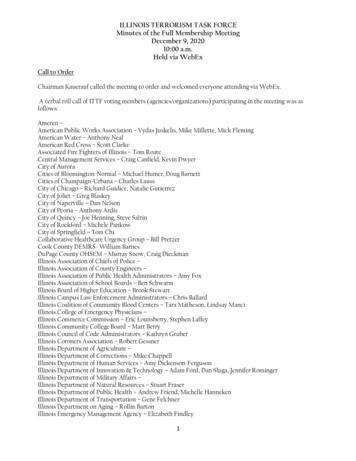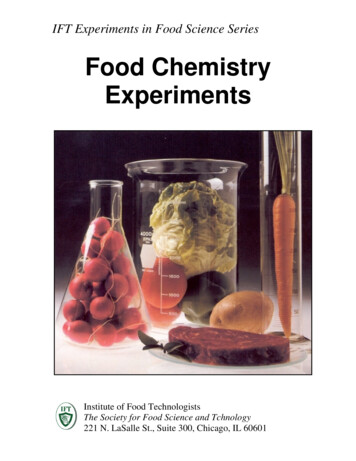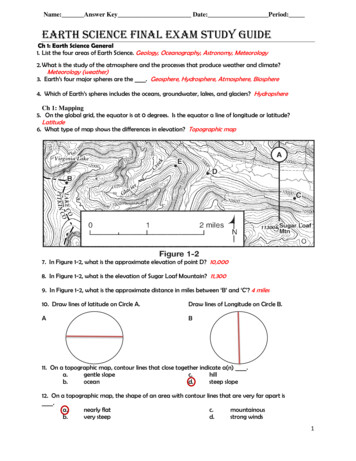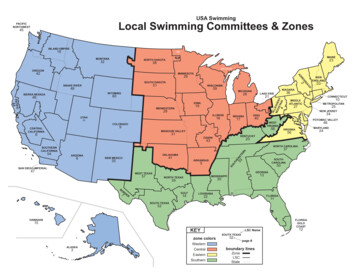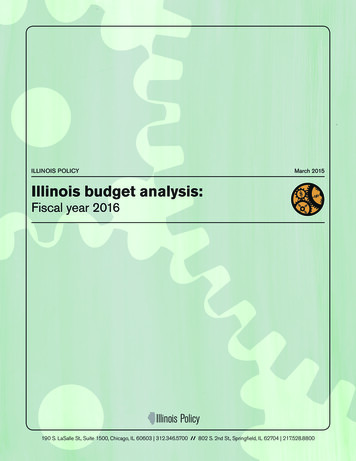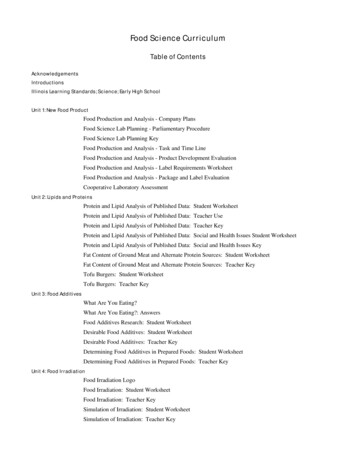
Transcription
Food Science CurriculumTable of ContentsAcknowledgementsIntroductionsIllinois Learning Standards; Science; Early High SchoolUnit 1: New Food ProductFood Production and Analysis - Company PlansFood Science Lab Planning - Parliamentary ProcedureFood Science Lab Planning KeyFood Production and Analysis - Task and Time LineFood Production and Analysis - Product Development EvaluationFood Production and Analysis - Label Requirements WorksheetFood Production and Analysis - Package and Label EvaluationCooperative Laboratory AssessmentUnit 2: Lipids and ProteinsProtein and Lipid Analysis of Published Data: Student WorksheetProtein and Lipid Analysis of Published Data: Teacher UseProtein and Lipid Analysis of Published Data: Teacher KeyProtein and Lipid Analysis of Published Data: Social and Health Issues Student WorksheetProtein and Lipid Analysis of Published Data: Social and Health Issues KeyFat Content of Ground Meat and Alternate Protein Sources: Student WorksheetFat Content of Ground Meat and Alternate Protein Sources: Teacher KeyTofu Burgers: Student WorksheetTofu Burgers: Teacher KeyUnit 3: Food AdditivesWhat Are You Eating?What Are You Eating?: AnswersFood Additives Research: Student WorksheetDesirable Food Additives: Student WorksheetDesirable Food Additives: Teacher KeyDetermining Food Additives in Prepared Foods: Student WorksheetDetermining Food Additives in Prepared Foods: Teacher KeyUnit 4: Food IrradiationFood Irradiation LogoFood Irradiation: Student WorksheetFood Irradiation: Teacher KeySimulation of Irradiation: Student WorksheetSimulation of Irradiation: Teacher Key
Unit 5: Food PackagingExperiment Design: Food Packaging TechnologyUnit 6: Food BiotechnologyFood Preservation Techniques: Student WorksheetEvaluating a Food and Making It Better: Student WorksheetAnalysis of Marketing a Food Product: Student WorksheetAnalysis of Marketing a Food Product: Teacher KeyWhat is Genetic Engineering?Unit 7: Food PoisoningFood Poisoning Scenario: Student ActivityFood Poisoning Scenario: Teacher KeyAll That Glitters Is Not GoldEffectiveness of HandwashingThe Case of the Unsuspecting MurdererTyphoid Mary QuizTyphoid Mary Quiz KeySurface Cleanliness Lab: Student WorksheetSurface Cleanliness Lab: Teacher KeyBacteria on Fresh Foods LabBacteria on Fresh Foods KeyAppendixFood ScienceFHA/HERO Proficiency Event - Food Science/TechnologyFHA/HERO Proficiency Event - Food Science/Technology EvaluationActivities Useful In All UnitsExperiment Lab Form and IntroductionSafety GuidelinesElectrical SafetyChemical SafetyPersonal and Clothing SafetyEye/Vision SafetyFire SafetyHand Safety and ProtectionGlassware SafetyPersonal Hygiene and SafetyWaste DisposalEquipment Use and SafetySafety Precaution Symbols for TransparenciesSafety and Precautions Pictures with BlanksSafety Rules - State of IllinoisSafety Contract
Rubric and EvaluationsClassroom Assessment and Rubric for Oral PresentationsClassroom Assessment and Rubric List for WritingA Review of the Scientific Method
ACKNOWLDEGEMENTSSpecial recognition and appreciation are extended to the following people who served on each of the teams forthe Integrating Education in Science and Technology. The diligent work of the team leaders was the driving forcein producing the draft products for teacher review and testing. The team members were teachers and universitystaff from around the state. The efforts will be instrumental in heightening our interest and expertise in ourteaching the sciences in Illinois.Gwen Pollock, Project CoordinatorDeb Larson, Food Sciences Product LiaisonTom Wiles, Agricultural Sciences LiaisonJohn Kopatz, Technologies LiaisonFOOD SCIENCES PRODUCT TEAM:Carla Nilson, Team Leader for Food Sciences, Herrin High School, HerrinSheila Ashbrook, Chemistry and Nutrition, Illinois Wesleyan University/University of Illinois, ChampaignTheresa Borkowicz, Family and Consumer Sciences, St. Charles High School, St. CharlesJudy Brower, Family and Consumer Sciences, Carl Sandburg High School, Orland ParkBillye Griswold, Family and Consumer Sciences, Carrollton HighSchool, CarrolltonKathy Hocker, Chemistry, Bloom Trail High School, Chicago HeightsLarry Kepple, Biology, Herrin High School, HerrinJohn Marlin, General Science, Sparta High School, SpartaPam Meyer, Family and Consumer Sciences, Sparta High School,SpartaPam Neubauer, Chemistry, Governors State University, University ParkAGRICULTURAL SCIENCES PRODUCT TEAM:Dr. Jeff Moss, Agricultural Sciences Product Team Leader, University of Illinois, ChampaignMary Barnes, Agriculture, Barry High School, BarryJeff Bash, Agriculture, Midwest Central High School, ManitoTeri Dring, Biology, (Not teaching this year)Chris Embry Mohr, Agriculture, Olympia High School, StanfordRon Morrison, Physics/Science, Paxton-Buckley-Loda High School, PaxtonJoe Steffen, Agriculture, Newark High School, NewarkMike White, Agriculture, Paxton-Buckley-Loda High School, PaxtonMatt Wilson, Agriculture, Somonauk High School, SomonaukTECHNOLOGIES AND SCIENCES PRODUCT TEAM:Dr. Mike Daugherty, Technologies and Sciences Product Team Leader, Illinois State University, NormalJeff Bair, Technology Education, Eureka High School, EurekaBrad Dearing, Technology Education, St. Charles High School, DeKalbScott Noles, Technology Coordinator, University High School, NormalDebbie Tschopp, Physics, Dakota High School, DakotaKelly Podzimek, Technology Education, Illinois State University, Normal
INTEGRATING EDUCATION IN SCIENCE AND TECHNOLOGYINTRODUCTIONThe Illinois State Board of Education, through Scientific Literacy funding, has begun a partnershipeffort between professional teacher organizations specifically to promote a new collegiality among ourteachers based on the newly adopted Illinois Learning Goals and Standards for Science. Theorganizations initially involved include the Illinois Associations of Biology Teachers, ChemistryTeachers, Family and Consumer Science Teachers, Industrial Technology Teachers, Physics Teachers,Science Teachers, and Vocational Agriculture Teachers along with the Facilitation and Coordination inAgriculture Education team. The partnership provided a unique opportunity to bring together highschool teachers of Family and Consumer Science, Agriculture and Principles of Technology withBiology, Chemistry and Physics/Physical Science teachers to focus on integrating pure and appliedsciences. These concepts of these sciences must be able to bridge real-life, up-to-date technologies andcareer-related activities. It is our goal to build professional collegiality and enhance the expertise of onediscipline with another. The original planning team, composed of the presidents or representatives ofthese organizations, decided to work towards enhanced student and teacher learning, using thebenchmarks for science at the early and late high school levels in the Illinois Learning Standards. Thematerials, which were developed by teachers, (some representing their professional organizations) arethe focus of the series of one-day workshops during the Spring of 1998 at multiple locations around thestate for local review and piloting.STARTING WITH THE STANDARDSIn July, 1997, the State Board of Education formally adopted the Illinois Learning Standards andendorsed the learning benchmarks for early and late elementary, along with middle and early and latehigh school levels. The original team of science teachers who worked together to draft the goals,standards and benchmarks, worked hard to promote the unifying strategy of "All Three—All theTime—In Everything" for the sciences. We wanted to promote the processes of science in all of theconcepts of science, while making direct connections to real life.We believe that teaching the concepts of science should not be separated from the processes of scienceor its interactions with society. Neither can the processes of science be isolated from understanding theconcepts and the resulting implications to or from technology and society. The interactions and practicesof science require the understanding of what science is and how science works in order to beauthentically understood. Goal 11 is accepted as the science processes goal with standards addressingthe processes of inquiry and technological design. Goal 12 is the concepts goal, including two standardseach for life, physical and earth/space sciences. Goal 13 is the connections goal, focusing on theaccepted practices of science and the STS (science/ technology/ society) connections. For example, thechoice of physical science content from goal 12, standard C or D, should be complemented with theprocesses of science from goal 11, standard A or B or a combination of both, while making theconnections from goal 13 to its two standards. Promoting the students’ understanding of All Three—Allthe Time—In Everything as a teaching and learning strategy can allow students to build on theirknowledge and skills for science. In addition, their attitudes and behaviors for and from science canmature in an ongoing manner that allows more integrated thinking and problem-solving in the sciencesand related fields for lifelong learners.
As the INTEGRATING EDUCATION IN SCIENCE AND TECHNOLOGY project evolved, specialdirectional emphasis was made to organize all efforts around the early and late high school sciencebenchmarks. Generally the Agriculture team and the Food Science team proceeded from the Goal 12standards for Life and Physical Sciences (Standards A, B, C, and D), as they integrated in the processesof Goal 11 and the connections of Goal 13. The Principles of Technology team, however, initiallyfocused on Standard B from Goal 11, the technological design standard, as they connected to Goals 12and 13. Goal 13 was the starting point for the career interview activity which was included in theIntroduction Section of each product. This activity directs the perspective from the connections ofscience to the concepts and processes of science in Goal 11 and 12.PRODUCT OVERVIEWScientific Literacy funding provided teams of teachers from secondary science, agriculture, foodsciences and industrial technology the opportunity to work together to create and pilot the followingthree products:Integrating the Sciences and Foods materials brings closer together science and technology relating tothe food sciences, including food poisoning, biotechnology research implications, food irradiation, etc.Curriculum materials from the Food Science Experiment and Activity Guide from North Carolina andCORD Applications in Biology/Chemistry were expanded and the team approach to activities wasemphasized, as they align to the Illinois Science Goals 11, 12 and 13.The Technology and Science materials consist of activity-based learning to enhance the participants’abilities to use design and creative innovation in the classroom. These materials include experimentationand problem-solving activities especially geared toward the process of technological design described inGoal 11, as it applies to the concepts and connections of Goals 12 and 13.The Enhanced Biological and Physical Science Applications in Agriculture materials have beendesigned as extensions of selected experiments in the popular Biological Science Applications inAgriculture (BSAA) and Physical Science Applications in Agriculture (PSAA) curricula currently usedin many of Illinois’ high schools. Existing lab activities and experiments have been modified for easierunderstanding. New activities have been developed which connect agricultural management practiceswith underlying science concepts and principles, aligning with all three Science Learning Goals.GENERAL FORMAT OVERVIEWReaders will notice the common format in each of the three products created through this project.Specific benchmarks are noted in the upper left corner of each unit/activity. Key words are used toidentify each of these benchmarks. The key words are not intended to be exclusive or definitive, but asthinking starters or organizers for initial understanding. These benchmarks were the starting points forcurricular development and enhancement. Key concepts and skills are noted in the upper right handcorner as quick identifiers for the activity, using common unit topics.(Two tables follow this introduction, intended to be offered for assistance as teachers familiarizethemselves with the Illinois Learning Standards. The first table lists some suggested key words for theearly and late high school science goals, standards and benchmarks. An additional table noting only thewording of the goals, standards and benchmarks is also offered as a tool for future efforts, potentiallyresulting from this project.)
There are student instructions and interactions suggested, as well as generalized and more specificteacher preparation directions. Web sites have been suggested for possible connection and extension ofclassroom activities in the section labeled "Instructional Media Connections." Some popular examplesof applicable software have been suggested for classroom use. Suggestions are also offered forconnections to careers in each activity. In some cases, additional materials have been provided toenhance the piloting of the activities; most of these materials have been provided at no cost or very lowcosts from various national professional and commercial sources. Reference citations are noted at theconclusion of each unit.Three copies of product activity evaluations are included as self-mailing pages following thisIntroduction. It is hoped that each participant will ‘experiment’ with at least three activities presentedwithin the product received. It is very important to get teacher input for improving this draft version ofthe Integrating Education in Science and Technology products. Please return the form for eachactivity you are able to test before June 1. Feel free to share the products’ activities with yourcolleagues; duplicate the evaluations for additional ‘teacher experiments’ as needed.Each of the professional organizations have been asked to provide information about their organizationsand membership. Promoting and maintaining collegiality through the various state organizations can beinstrumental in the ongoing professional development for teachers throughout their careers.
Illinois Learning StandardsSCIENCEEARLY HIGH SCHOOL11 Understand the processes of scientific inquiry and technological design to investigatequestions, conduct experiments and solve problems.A. Know and apply the concepts, principles and processes of scientific inquiry.PROCESSESInquiry11.A.4 Formulate hypotheses referencing prior research and knowledge.Hypothesize11.A.4b Conduct controlled experiments or simulations to test hypotheses.Test hypothesis11.A.4c Collect, organize and analyze data accurately and precisely.Data management11.A.4d Apply statistical methods to the data to reach and support conclusions.Statistics conclusion11.A.4e Formulate alternative hypotheses to explain unexpected results.Alternative hypothesis11.A.4f Using available technology, report, display and defend to an audience conclusions drawnfrom investigations.Report/Defend conclusionsB. Know and apply the concepts, principles and processes of technological design.Technological design11.B.4a Identify a technological design problem inherent in a commonly used product.Identify problem11.B.4b Propose and compare different solution designs to the design problem based upon givenconstraints including available tools, materials and time.Propose/Compare solutions11.B.4c Develop working visualizations of the proposed solution designs (e.g., blueprints,schematics, flowcharts, cad-cam, animations).Modeling11.B.4d Determine the criteria upon which the designs will be judged, identify advantages anddisadvantages of the designs and select the most promising design.Determine criteria11.B.4e Develop and test a prototype or simulation of the solution design using available materials,instruments and technology.Prototype testing11.B.4f Evaluate the test results based on established criteria, note sources of error andrecommend improvements.Evaluation11.B.4g Using available technology, report to an audience the relative success of the design basedon the test results and criteria.Communication12 Understand the fundamental concepts, principles and interconnections of the life, physical andearth/space sciences.A. Know and apply concepts that explain how living things function, adapt and change.12.A.4a Explain how genetic combinations produce visible effects and variations among physicalfeatures and cellular functions of organisms.CONCEPTSLife-function, adaptation, changeGenetics
12.A.4b Describe the structures and organization of cells and tissues that underlie basic lifefunctions including nutrition, respiration, cellular transport, biosynthesis and reproduction.Physiology12.A.4c Describe processes by which organisms change over time using evidence from comparativeanatomy and physiology, embryology, the fossil record, genetics and biochemistry.Development of organisms over timeB. Know and apply concepts that describe how living things interact with each other and with theirenvironment.Life-Interactions12.B.4a Compare physical, ecological and behavioral factors that influence interactions andinterdependence of organisms.Interaction/Interdependence12.B.4b Simulate and analyze factors that influence the size and stability of populations withinecosystems (e.g., birth rate, death rate, predation, migration patterns).Population stabilityC. Know and apply concepts that describe properties of matter and energy and the interactionsbetween them.Phys-Matter/Energy12.C.4a Use kinetic theory, wave theory, quantum theory and the laws of thermodynamics toexplain energy transformations.Energy transformation12.C.4b Analyze and explain the atomic and nuclear structure of matter.Structure of matterD. Know and apply concepts that describe force and motion and the principles that explain them.Phys-Force/Motion12.D.4a Explain and predict motions in inertial and accelerated frames of reference.Inertia/Acceleration12.D.4b Describe the effects of electromagnetic and nuclear forces including atomic and molecularbonding, capacitance and nuclear reactions.Electromagnetic/Nuclear forcesE. Know and apply concepts that describe the features and processes of the Earth and its resources.Earth Systems12.E.4a Explain how external and internal energy sources drive Earth processes (e.g., solar energydrives weather patterns; internal heat drives plate tectonics).Earth energy sources12.E.4b Describe how rock sequences and fossil remains are used to interpret the age and changesin the Earth.Age of the EarthF. Know and apply concepts that explain the composition and structure of the universe and Earth’splace in it.Space Sciences12.F.4a Explain theories, past and present, for changes observed in the universe.Changes in universe12.F.4b Describe and compare the chemical and physical characteristics of galaxies and objectswithin galaxies (e.g., pulsars, nebulae, black holes, dark matter, stars).Galactic characteristics13 Understand the relationships among science, technology and society in historical andcontemporary contexts.A. Know and apply the accepted practices of science.CONNECTIONSPractices of science13.A.4a Estimate and suggest ways to reduce the degree of risk involved in science activities.Risk assessment13.A.4b Assess the validity of scientific data by analyzing the results, sample set, sample size,similar previous experimentation, possible misrepresentation of data presented and potential sourcesof error.Data validity13.A.4c Describe how scientific knowledge, explanations and technological designs may changewith new information over time (e.g., the understanding of DNA, the design of computers).Impact of new information13.A.4d Explain how peer review helps to assure the accurate use of data and improves thescientific process.Peer reviewB. Know and apply concepts that describe the interaction between science, technology and society.13.B.4a Compare and contrast scientific inquiry and technological design as pure and appliedsciences.STS InteractionsInquiry/pure: Design/applied
13.B.4b Analyze a particular occupation to identify decisions that may be influenced by aknowledge of science.Science in occupations13.B.4c Analyze ways that resource management and technology can be used to accommodatepopulation trends.Population trends13.B.4d Analyze local examples of resource use, technology use or conservation programs;document findings; and make recommendations for improvements.Local STS issue study13.B.4e Evaluate claims derived from purported scientific studies used in advertising and marketingstrategies.Science claims in advertising/marketing
New Food ProductAssociated Benchmarks11.B.4a - Identify Problem12.C.5b - Property AnalysisKey ConceptFood Productionand AnalysisProcess tivity ConnectionsIn this activity, students will develop a recipe for a "new food product," prepare the product in akitchen/lab, analyze the nutritional and sensory characteristics of the product, and makemodifications if desired. Although students cannot exactly replicate the technology used incommercial food production, they can simulate other aspects of food product development suchas determining food composition data for labels and evaluating and modifying the sensorycharacteristics of the product.If desired, this activity can be extended to include the development of a food label for theproduct, as well as advertising and marketing strategies. The attached activity (Food Science LabPlanning - pages 1.5-1.9) could also be used in evaluating the student-designed food products.Time length - Total of 4 weeks. Various portions could be completed in stages or used alone.Career Connection (13.B.4b)Through this activity, students will become familiar with some of the activities of scientistsworking in the food industry.Teacher InstructionsPrior to this activity, students should have developed some familiarity with commercial foodprocessing techniques. They should recognize that they cannot imitate exactly the commercialprocesses, but can engage in some of the same activities that are involved in commercial foodproduct development.
Materials needed for this project will vary, depending upon the products selected for preparation by thestudents. In general, food preparation equipment and food ingredients will be needed. Students will alsoneed access to information on food composition, which is available in text format, via computersoftware, or via the web site listed below.Use the Cooperative Laboratory Assessment to evaluate students in company or team work.Student InteractionThe following general instructions can be used to guide students in this activity:1. Start the activity by having students look at and discuss some of the newer food products insupermarkets, including the appeal of such products, and the technologies which make theseproducts possible.2. Ask students to develop an idea for a "new" food product which could be prepared using noncommercial techniques, i.e., which can be produced in a standard kitchen using commoningredients. Students should be aware that there are some ways in which they can simulate, if notreplicate, commercial products like reduced-fat baked goods.3. Next, students should find or develop a recipe for the product they want to produce. In manycases, they can start with a standard recipe and make modifications.4. Once students have their initial recipe formulated, they should prepare it, and then have fellowstudents do a sensory analysis of the product, analyzing it in terms of taste, texture, etc.5. Depending upon the results of the sensory analysis, students may want to modify their originalrecipe and repeat the preparation and analysis steps.6. Now students are ready to determine the nutrient composition of their food, and, if desired, aningredients list which would conform to labeling requirements (i.e., listing ingredients byweight).7. Finally, students might want to consider the types of food additives that could be used to enhancethe quality and safety of their product. They should indicate what additive, or type of additivethey would use and for what purpose.Instructional Media ConnectionsInstitute of Food Technologists http://www.ift.org/This site includes information on food product development.Nutrition Analysis Tool http://nat.crgq.com/This program can be used to determine the nutrient composition of a recipe; input ingredients instead offoods.Nutrient Analysis System 2: This is one software program which can be used to determine the nutrientcontents of foods. It is from DDA Software, P.O. Box 477, Long Valley, NJ 07853, 908-876-5580.
NDSU Extension Service, University of North Dakota http://www.ag.ndsu.nodak.edu/food.htmA very large list of links covering: Emphasis on NutritionNutrition DirectoriesFood SafetyFood/AgricultureHealthResources for KidsOther Internet ResourcesReferencesFood Science Experiment and Activity Guide, Issued by Home Economics Education, Vocationaland Technical Education, North Carolina Department of Public Instruction, Raleigh, NorthCarolina 27601-2825, August 1994.
NAME: DATE: CLASS PERIOD:STUDENT WORKSHEET -Food Production and Analysis - Company PlansCompany MembersJob TitleFood ScientistFood Engineer and FlavoristMarketingCompany NameProduct NameTarget AudienceBrief description of product:Type of packaging:Type of marketing:
NAME: DATE: CLASS PERIOD:Food Science Lab Planning - Parliamentary ProcedureEXPERIMENT 20-01SAFETY: Write your initials under the symbols that represent safety precautions for this lab.INTRODUCTION:Regardless of whether you are at home, in the classroom, or on the job, an orderly system foraccomplishing your goals or plans is needed. When two or more people are involved, the rights andopinions of each individual need to be considered. Parliamentary Procedure has four principles: courtesyand justice to all, one item of business at a time, the minority must be heard, and the majority mustprevail. Knowing proper procedures for handling formal or informal meetings helps things runsmoothly. Consider the planning that takes place within your classroom for effective and successfulinstruction.PROCEDURE:1. Select a dessert item to prepare for the entire class to enjoy. Selection must be made through theuse of Parliamentary Procedure. You must include in the planning and selection process the useof a motion, debate, and the use of one method of voting - voice vote, roll call, or ballot.Remember the majority rules.2. Prepare the following: timeline chart - includes task descriptions and assignments, start time, length of task,and finish time materials list - includes supplies, equipment, and facility needs product evaluation form3. Record information in step 2 in the data tables provided.
DATA TABLE 1: Timeline ChartFood Item to be Prepared:Task Descriptions andAssignmentsLength of TaskStart TimeCompletion Time
DATA TABLE 2: Materials, Supplies, Equipment, Facilities/SpaceMaterials/SuppliesIn-stockNeed to Order
Equipment NeedsAvailabilityCondition
Facility/Space Requirements(Write a brief description of your facility/space requirements for this experiment.)
DATA TABLE 3: Product EvaluationProduct EvaluationClean-Up Instructions:QUESTIONS:1. What problems, if any, did the class encounter when deciding on the dessert to be prepared?2. Determine the benefits of using parliamentary procedure when group decisions are being madethat will affect the entire group.
FOR TEACHER USEANSWER KEYFood Science Lab Planning - Parliamentary ProcedureTime: 2 class periodsSafety: Have students initial the following safety precautions before proceeding with this lab.(Note: Items listed below are suggested; other items may need to be addressed based on food itemsselected for this experiment.) Electrical Safety - Handle electrical equipment with care; plug and unplug with dry hands andwith care.Personal and Clothing Safety- Wear an apron to protect clothing.Fire Safety- Use care with heat source.Hand Safety and Protection - Use hot mitts; handle knives with care.Personal Hygiene and Safety - Use sanitary practices in the foods lab.Equipment Use and Safety - Use safety practices with all equipment.Materials and Equipment NeededSupplies will varydepending on the recipeselected by the class.How can this lab be applied within the home? Within the workplace?ANSWERS:1. Answers will vary2. Minority is heard, majority rules.TEACHER NOTE: Resources: FHA/HERO Chapter Handbook; Robert’s Rules of Order (Newly Revised)
NAME: DATE: CLASS PERIOD:STUDENT WORKSHEET: FOOD PRODUCTION AND ANALYSIS - TASK/TIME LINECompletion Date Task1. Brainstorm new food product2. Feasibility Survey (Is there a need to develop the new product?)Develop questionsSurveySummarize results3. Market Research (Identify product qualities similar to the product you planto develop)Consumer AppealPackaging TechniquesTechnology UsedProcessingPreservativesNutrient ValuePrice VariationSize Availability
Brands4. Develop New Product Recipe5. Research ReportProcessing TechniquesIngredientsNutrient FunctionsPreservatives6. Develop Sensory Evaluation Questions7. Prepare Developed Recipe8. Determine WeightEach IngredientTotal RecipeAmount of Product in Container9. Sensory Evaluation Survey and Summary of Results10. Modify Developed Recipe11. Develop Accurate Nutrient Label Using Nutrient Analysis Program12. Develop Accurate Label for Package13. Develop Marketing Scheme14. Prepare Display of Company Work
NAME: DATE: CLASS PERIOD:FOOD PRODUCTION AND ANALYSIS - Product Development EvaluationScorePossiblePointsContentCover PageRecipe
Food Science Curriculum Table of Contents Acknowledgements Introductions Illinois Learning Standards; Science; Early High School Unit 1: New Food Product Food Production and Analysis - Company Plans Food Science Lab Planning - Parliamentary Procedure Food Science Lab Planning Key Food Production and Analysis - Task and Time Line
